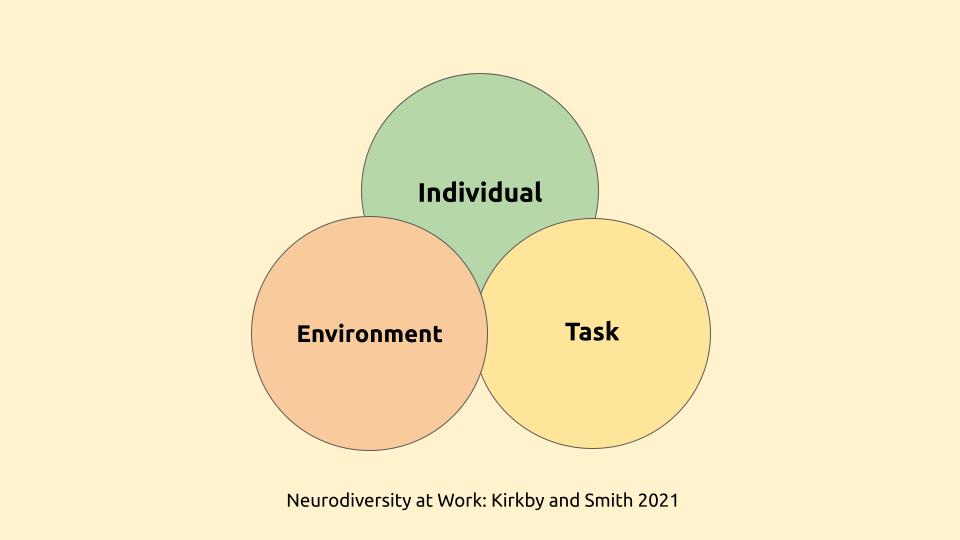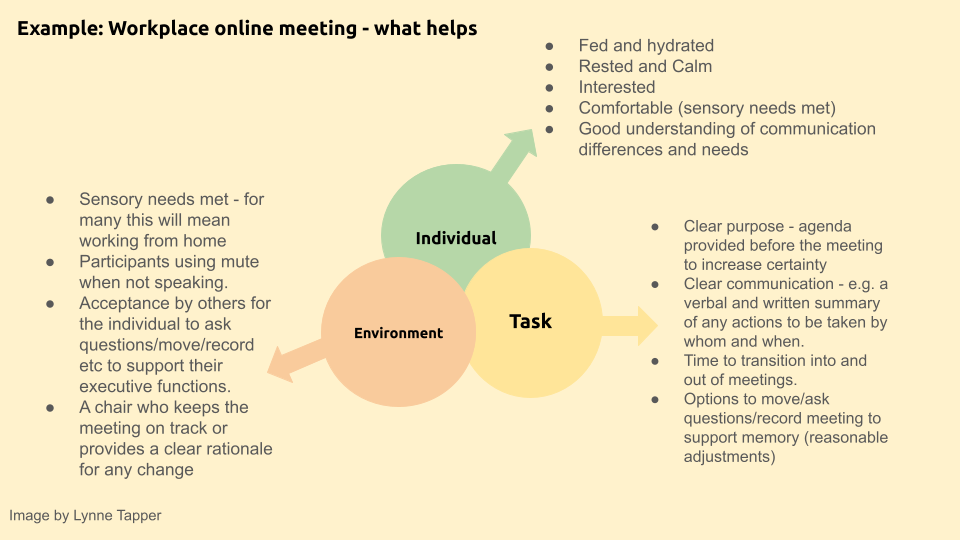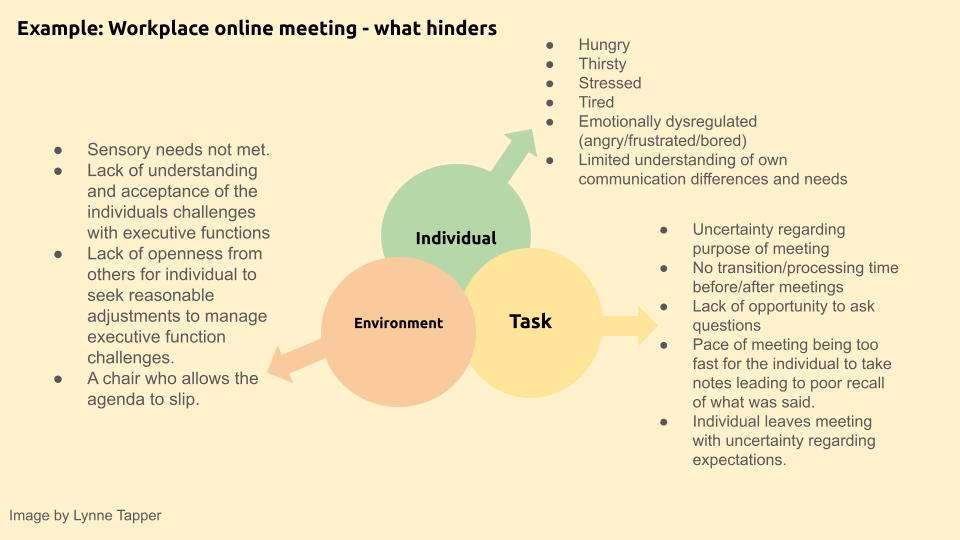Key messages:
- Common strengths in Autistic and ADHD communication.
- Executive functions – what they are and how they impact communication.
- Communication is situationally variable.
- What helps and hinders communication using a situational variability model applied to an online meeting example.
Table of contents
- Autistic & ADHD Communication Strengths
- Autistic & ADHD Communication Challenges – The Impact of Executive Functions
- Communication is Situationally Variable
Autistic & ADHD Communication Strengths
Many neurodivergent people relate to the concept of a ‘spiky profile’ when considering their strengths and challenges. Most neurotypical individuals experience a more gradual contrast between personal areas of strength and difficulty. In contrast, neurodivergent individuals often have a sharp contrast between areas of strength and challenge, with many exhibiting both above-average abilities and above-average difficulties. While no two neurodivergent people are the same, certain strengths are frequently associated with specific neurotypes.
For example, many autistic people excel in honesty and fairness. This means they are more likely to tell the truth and give honest feedback. This can be a valuable and necessary antidote to mistakes that happen when processes and procedures have not been critically reviewed.
A common misperception is that autistic people have a communication deficit. In reality, autistic communication is different rather than deficient. Research by Crompton et al. (2020) found that autistic-to-autistic communication does not break down significantly more than communication between non-autistics. Difficulties can often arise in cross-neurotype interactions, especially when there is a lack of understanding of communication differences and effort to accommodate tehse differences.
Many ADHDers have strengths in curiosity, a love of learning, and creativity. They tend to ask many questions when engaged with a topic of interest. ADHDers often use vivid metaphors and analogies, making their conversations dynamic. However, they may also jump between topics as their brains make rapid connections that may not be immediately obvious to others.
Autistic & ADHD Communication Challenges – The Impact of Executive Functions
The ‘spiky profiles’ of ADHDers and many autistic individuals often include challenges related to executive functions. Executive functioning refers to the brain’s ability to plan, organize, and execute tasks. A useful framework for understanding this is Brown’s AFEEMA model, which categorizes executive function into six interrelated areas. These functions are not fixed but fluctuate depending on various factors. Below is a breakdown of these areas and their impact on communication.
Activation – Getting started, organizing, and prioritizing.
Potential challenges:
- Providing excessive information due to difficulty prioritizing key details.
- Jumping between topics or omitting essential details, making it hard for others to follow.
- Struggling to initiate conversations.
- Going in circles without reaching a decision.
- Asking numerous questions to clarify instructions.
Focus – Attention, transitions, and managing distractions.
Potential challenges:
- Asking a question but not being fully attentive to the answer.
- Not responding when absorbed in a task.
- Struggling to focus in distracting environments.
- Difficulty shifting from an interesting topic, even when others disengage.
Effort – The energy required for communication.
Potential challenges:
- Inconsistent communication patterns, such as frequent messages followed by long periods of silence.
- A mismatch between written and verbal communication preferences.
- Becoming non-speaking when overwhelmed.
Emotion – Emotional regulation.
Potential challenges:
- Experiencing sudden emotional escalations.
- Blurting things out, snapping, or shouting impulsively.
- Shutting down or withdrawing when overwhelmed.
- Difficulty identifying and labeling emotions (alexithymia).
- Oversharing personal information impulsively.
Memory – Short-term working memory limitations.
Potential challenges:
- Repeatedly asking questions due to forgetting previous answers.
- Interrupting conversations to avoid forgetting thoughts.
- Difficulty remembering names immediately after introductions.
Monitoring Action – Self-awareness during communication.
Potential challenges:
- Speaking too fast or too much, monopolizing conversations.
- Speaking too little and not providing enough information.
- Missing social cues that indicate someone wants to end a conversation.
These examples illustrate how executive function challenges impact communication. However, it is essential to remember that communication ability is situationally variable—it depends on the person’s current state, the task at hand, and the environment.
Communication is Situationally Variable

I first came across the concept of situational variability in Neurodiversity at Work by Kirkby and Smith (2021) and later through training provided by Gold Mind Academy.
When communication challenges arise, the situational variability model helps analyze the situation by considering three key factors:
- The Individual – Their current state
- The Task – The nature of the conversation and its complexity and the demands on executive functioning
- The Environment – The physical setting and the people involved.
Below is an example of how these factors influence communication in an online office meeting:

Helpful Factors: Clear meeting agendas, minimal background noise, time to process responses, and accessible chat functions for written contributions.

- Hindering Factors: Unclear expectations, rapid topic shifts, overwhelming visual stimuli, and lack of alternative communication options.
This model is not exhaustive but provides a useful framework for identifying what helps or hinders communication in different contexts.
By applying this model, individuals can explore some of the factors that are impacting on their communication success and through this:
- Recognize their own communication needs.
- Advocate for accommodations that support effective interactions.
References
- Crompton et al.., 2020. Autistic peer-to-peer information transfer is highly effective. Autism: The International Journal of Research and Practice.
- The Brown Model of Executive Function Impairments in ADHD. Brown ADHD Clinic
- Kirkby & Smith, 2021. Neurodiversity at Work.
- Gold Mind Academy. Website





